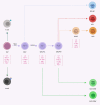NK Cell Development in Times of Innate Lymphoid Cell Diversity
- PMID: 32733432
- PMCID: PMC7360798
- DOI: 10.3389/fimmu.2020.00813
NK Cell Development in Times of Innate Lymphoid Cell Diversity
Abstract
After being described in the 1970s as cytotoxic cells that do not require MHC-dependent pre-activation, natural killer (NK) cells remained the sole member of innate lymphocytes for decades until lymphoid tissue-inducer cells in the 1990s and helper-like innate lymphoid lineages from 2008 onward completed the picture of innate lymphoid cell (ILC) diversity. Since some of the ILC members, such as ILC1s and CCR6- ILC3s, share specific markers previously used to identify NK cells, these findings provoked the question of how to delineate the development of NK cell and helper-like ILCs and how to properly identify and genetically interfere with NK cells. The description of eomesodermin (EOMES) as a lineage-specifying transcription factor of NK cells provided a candidate that may serve as a selective marker for the genetic targeting and identification of NK cells. Unlike helper-like ILCs, NK cell activation is, to a large degree, regulated by the engagement of activating and inhibitory surface receptors. NK cell research has revealed some elegant mechanisms of immunosurveillance, coined "missing-self" and "induced-self" recognition, thus complementing "non-self recognition", which is predominantly utilized by adaptive lymphocytes and myeloid cells. Notably, the balance of activating and inhibitory signals perceived by surface receptors can be therapeutically harnessed for anti-tumor immunity mediated by NK cells. This review aims to summarize the similarities and the differences in development, function, localization, and phenotype of NK cells and helper-like ILCs, with the purpose to highlight the unique feature of NK cell development and regulation.
Keywords: NK cells; immune receptor; immune recognition; innate lymphocytes; innate lymphoid cells.
Copyright © 2020 Stokic-Trtica, Diefenbach and Klose.
Figures



Similar articles
-
Heterogeneity of NK Cells and Other Innate Lymphoid Cells in Human and Murine Decidua.Front Immunol. 2019 Feb 8;10:170. doi: 10.3389/fimmu.2019.00170. eCollection 2019. Front Immunol. 2019. PMID: 30800126 Free PMC article. Review.
-
Natural killer cells and type 1 innate lymphoid cells in cancer.Semin Immunol. 2023 Mar;66:101709. doi: 10.1016/j.smim.2022.101709. Epub 2023 Jan 6. Semin Immunol. 2023. PMID: 36621291 Review.
-
Helper-like Innate Lymphoid Cells in Humans and Mice.Trends Immunol. 2020 May;41(5):436-452. doi: 10.1016/j.it.2020.03.002. Epub 2020 Mar 26. Trends Immunol. 2020. PMID: 32223931 Review.
-
Activating and inhibitory receptors expressed on innate lymphoid cells.Semin Immunopathol. 2018 Jul;40(4):331-341. doi: 10.1007/s00281-018-0685-x. Epub 2018 May 22. Semin Immunopathol. 2018. PMID: 29789862 Review.
-
Innate Lymphoid Cells: Expression of PD-1 and Other Checkpoints in Normal and Pathological Conditions.Front Immunol. 2019 Apr 26;10:910. doi: 10.3389/fimmu.2019.00910. eCollection 2019. Front Immunol. 2019. PMID: 31105707 Free PMC article. Review.
Cited by
-
Natural killer cell-based cancer immunotherapy: from basics to clinical trials.Exp Hematol Oncol. 2024 Oct 16;13(1):101. doi: 10.1186/s40164-024-00561-z. Exp Hematol Oncol. 2024. PMID: 39415291 Free PMC article. Review.
-
Nanoparticles in tumor microenvironment remodeling and cancer immunotherapy.J Hematol Oncol. 2024 Apr 2;17(1):16. doi: 10.1186/s13045-024-01535-8. J Hematol Oncol. 2024. PMID: 38566199 Free PMC article. Review.
-
Group 1 ILCs: Heterogeneity, plasticity, and transcriptional regulation.Immunol Rev. 2024 May;323(1):107-117. doi: 10.1111/imr.13327. Epub 2024 Apr 2. Immunol Rev. 2024. PMID: 38563448 Review.
-
CAR-NK cells for cancer immunotherapy: recent advances and future directions.Front Immunol. 2024 Feb 9;15:1361194. doi: 10.3389/fimmu.2024.1361194. eCollection 2024. Front Immunol. 2024. PMID: 38404574 Free PMC article. Review.
-
The role of CD56bright NK cells in neurodegenerative disorders.J Neuroinflammation. 2024 Feb 13;21(1):48. doi: 10.1186/s12974-024-03040-8. J Neuroinflammation. 2024. PMID: 38350967 Free PMC article. Review.
References
Publication types
MeSH terms
Substances
LinkOut - more resources
Full Text Sources
Research Materials

